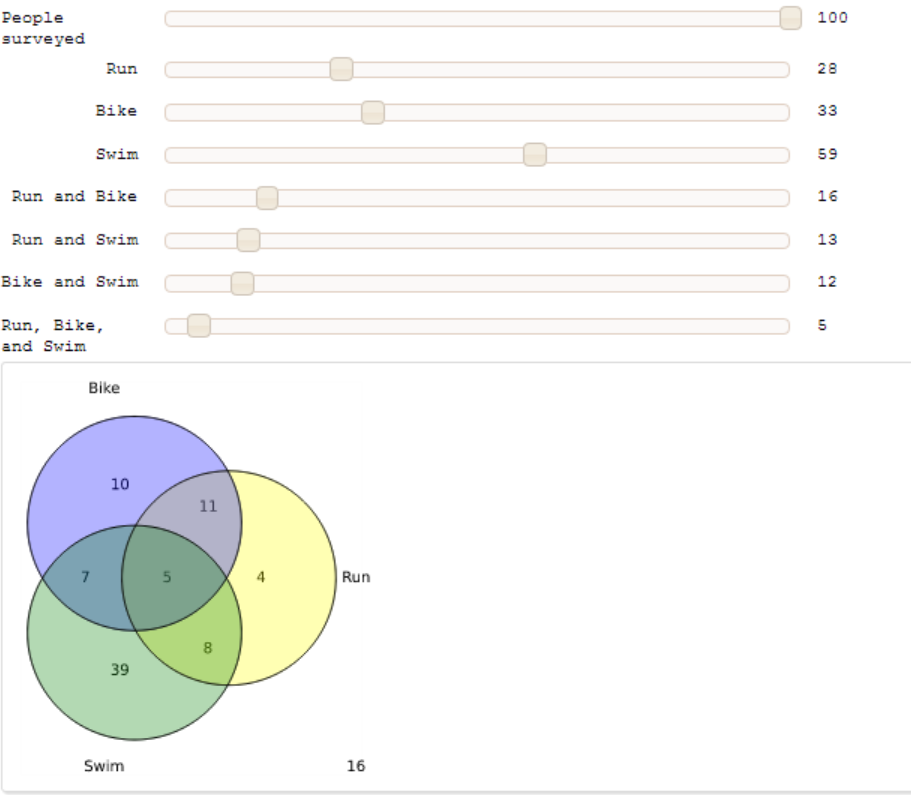|
Size: 7713
Comment:
|
Size: 12902
Comment:
|
| Deletions are marked like this. | Additions are marked like this. |
| Line 8: | Line 8: |
| by Marshall Hampton {{{ |
by Marshall Hampton. When the two frequencies are well separated, we hear the right hand side of the identity. When they start getting close, we hear the higher-pitched factor in the left-hand side modulated by the lower-pitched envelope. {{{#!sagecell |
| Line 17: | Line 17: |
| self.sr = 44100 | self.sr = int(4100) |
| Line 28: | Line 28: |
| def sinsound(freq_ratio = slider(0,1,1/144,1/12)): | def sinsound(freq_ratio = slider(1/144,1,1/144,1/12)): |
| Line 31: | Line 31: |
| html('$\cos(\omega t) - \cos(\omega_0 t) = 2 \sin(\frac{\omega + \omega_0}{2}t) \sin(\\frac{\omega - \omega_0}{2}t)$') | html(r' |
| Line 35: | Line 35: |
| s2str = '' for x in s2f: s2str += wave.struct.pack('h',x) lab=str(float(freq_ratio)) |
s2str = b''.join(wave.struct.pack('f',x) for x in s2f) lab="%1.2f"%float(freq_ratio) |
| Line 43: | Line 41: |
| html('<embed src="https:./test'+ lab +'.wav" width="200" height="100"></embed>') html('Frequencies: '+ '$\omega_0 = ' + str(hz1) + ' |
pretty_print(html(r'<embed src="cell://test'+ lab +'.wav" width="200" height="100"></embed>')) pretty_print(html(r'Frequencies: $\omega_0 = {} |
| Line 48: | Line 46: |
| == Karplus-Strong algorithm for plucked and percussive sound generation == by Marshall Hampton {{{#!sagecell import wave class SoundFile: def __init__(self, signal,lab=''): self.file = wave.open('./test' + lab + '.wav', 'wb') self.signal = signal self.sr = int(44100) def write(self): self.file.setparams((1, 2, self.sr, 44100*4, 'NONE', 'noncompressed')) self.file.writeframes(self.signal) self.file.close() mypi = float(pi) from math import sin def ks(delay,length,blend = 0,filler=None,stretch=0): if filler == None: filler = [randint(-16383,16383) for q in range(delay+1)] outsig = filler[:] index = len(filler) while len(outsig) < length: s = random() if s > stretch: b = random() if b < 1-blend: newvalue = (outsig[index-delay]+outsig[index-delay-1])*.5 else: newvalue = -(outsig[index-delay]+outsig[index-delay-1])*.5 else: newvalue = outsig[index-delay] outsig.append(newvalue) index += 1 return [int(round(x)) for x in outsig] @interact def sinsound(delay = slider([int(2^i) for i in range(2,10)], default=100, label="initial delay"), blend=slider(srange(0,1,.01,include_endpoint=True),default=0,label="blend factor"), stretch=slider(srange(0,1,.01,include_endpoint=True),default=0,label="stretch factor")): s2f = ks(delay,int(44100*(1/2)),blend=blend,stretch=stretch) for i in range(12): s2f = s2f + ks(int(2^((12+i)/12.0)*delay),int(44100*(1/2)),blend=blend, stretch=stretch) pretty_print(html("Karplus-Strong algorithm with blending and delay stretching")) pretty_print(html("<br>K. Karplus and A. Strong, <em>Digital synthesis of plucked string and drum timbres</em>, \nComputer Music Journal 7 (2) (1983), 43–55.<br>")) pretty_print(html("Initial waveform:")) show(list_plot(s2f[0:2000],plotjoined=True), figsize = [7,3.5]) pretty_print(html("Waveform after stabilization:")) show(list_plot(s2f[20000:22000],plotjoined=True), figsize = [7,3.5]) s2str = b''.join(wave.struct.pack('f',x) for x in s2f) lab="" f = SoundFile(s2str,lab=lab) f.write() pretty_print(html('<embed src="cell://test'+ lab +'.wav" width="200" height="100"></embed>')) }}} {{attachment:KarplusStrong.png}} |
|
| Line 51: | Line 107: |
| {{{ | {{{#!sagecell |
| Line 62: | Line 118: |
| XY = X.intersection(Y) XZ = X.intersection(Z) YZ = Y.intersection(Z) XYZ = XY.intersection(Z) html('<center>') html(" html(" html(" html(" html('</center>') |
XY = X & Y XZ = X & Z YZ = Y & Z XYZ = XY & Z pretty_print(html("<center><p> |
| Line 92: | Line 143: |
| Z = set(S[i]).intersection(S[(i+1)%3]).difference(set(XYZ)) | Z = (set(S[i]) & S[(i+1)%3]) - set(XYZ) |
| Line 107: | Line 158: |
| {{{ | {{{#!sagecell |
| Line 110: | Line 161: |
| print (lambda f:f(0,f))( | print((lambda f:f(0,f))( |
| Line 115: | Line 166: |
| ) | )) |
| Line 121: | Line 172: |
| {{{ html('<h2>Profile the given input</h2>') |
{{{#!sagecell pretty_print(html('<h2>Profile the given input</h2>')) |
| Line 128: | Line 179: |
| print "<html>" # trick to avoid word wrap | |
| Line 130: | Line 180: |
| cProfile.run(cmd) | cProfile.runctx(cmd,globals(), locals()) |
| Line 132: | Line 182: |
| profile.run(cmd) print "</html>" |
profile.runctx(cmd,globals(), locals()) |
| Line 141: | Line 190: |
| {{{ | {{{#!sagecell |
| Line 144: | Line 193: |
| print globals()[system].eval(code) | print(globals()[system].eval(code)) |
| Line 149: | Line 198: |
| == A Random Walk == by William Stein {{{ html('<h1>A Random Walk</h1>') vv = []; nn = 0 @interact def foo(pts = checkbox(True, "Show points"), refresh = checkbox(False, "New random walk every time"), steps = (50,(10..500))): # We cache the walk in the global variable vv, so that # checking or unchecking the points checkbox doesn't change # the random walk. html("<h2>%s steps</h2>"%steps) global vv if refresh or len(vv) == 0: s = 0; v = [(0,0)] for i in range(steps): s += random() - 0.5 v.append((i, s)) vv = v elif len(vv) != steps: # Add or subtract some points s = vv[-1][1]; j = len(vv) for i in range(steps - len(vv)): s += random() - 0.5 vv.append((i+j,s)) v = vv[:steps] else: v = vv L = line(v, rgbcolor='#4a8de2') if pts: L += points(v, pointsize=10, rgbcolor='red') show(L, xmin=0, figsize=[8,3]) }}} {{attachment:randomwalk.png}} == 3D Random Walk == {{{ @interact def rwalk3d(n=(50,1000), frame=True): pnt = [0,0,0] v = [copy(pnt)] for i in range(n): pnt[0] += random()-0.5 pnt[1] += random()-0.5 pnt[2] += random()-0.5 v.append(copy(pnt)) show(line3d(v,color='black'),aspect_ratio=[1,1,1],frame=frame) }}} {{attachment:randomwalk3d.png}} |
|
| Line 203: | Line 201: |
| {{{ def minkdemo(list1,list2): |
{{{#!sagecell def minkdemo(list1, list2): |
| Line 206: | Line 204: |
| Returns the Minkowski sum of two lists. | Return the Minkowski sum of two lists. |
| Line 211: | Line 209: |
| temp = [stuff1[i] + stuff2[i] for i in range(len(stuff1))] output.append(temp) |
output.append([a + b for a, b in zip(stuff1, stuff2)]) |
| Line 214: | Line 211: |
| @interact def minksumvis(x1tri = slider(-1,1,1/10,0, label = 'Triangle point x coord.'), yb = slider(1,4,1/10,2, label = 'Blue point y coord.')): t_list = [[1,0],[x1tri,1],[0,0]] |
@interact def minksumvis(x1tri=slider(-1,1,1/10,0, label='Triangle point x coord.'), yb=slider(1,4,1/10,2, label='Blue point y coord.')): t_list = [[1,0], [x1tri,1], [0,0]] |
| Line 227: | Line 225: |
| for an_edge in p12poly.vertex_adjacencies(): edge_lines = edge_lines + line([verts[an_edge[0]], verts[an_edge[1][0]]]) edge_lines = edge_lines + line([verts[an_edge[0]], verts[an_edge[1][1]]]) |
for v0, v1 in p12poly.graph().edges(False): edge_lines += line([v0, v1]) |
| Line 235: | Line 232: |
| triangle_sum = triangle_sum + polygon(temp_list, alpha = .5, rgbcolor = (1,0,0)) | triangle_sum += polygon(temp_list, alpha = .5, rgbcolor = (1,0,0)) |
| Line 241: | Line 238: |
| kite_sum = kite_sum + polygon(temp_list, alpha = .3,rgbcolor = (0,0,1)) | kite_sum += polygon(temp_list, alpha = .3,rgbcolor = (0,0,1)) |
| Line 243: | Line 240: |
| labels = labels + text('=', (-.2,.5), rgbcolor = (0,0,0)) | labels += text('=', (-.2,.5), rgbcolor = (0,0,0)) |
| Line 247: | Line 244: |
== Cellular Automata == by Pablo Angulo, Eviatar Bach {{{#!sagecell from numpy import zeros from random import randint def cellular(rule, N, initial='Single-cell'): '''Yields a matrix showing the evolution of a Wolfram's cellular automaton rule: determines how a cell's value is updated, depending on its neighbors N: number of iterations initial: starting condition; can be either single-cell or a random binary row ''' M=zeros( (N,2*N+2), dtype=int) if initial=='Single-cell': M[0,N]=1 else: M[0]=[randint(0,1) for a in range(2*N+2)] for j in range(1,N): for k in range(2*N): l = 4*M[j-1,k-1] + 2*M[j-1,k] + M[j-1,k+1] M[j,k]=rule[ l ] return M[:,:-1] def num2rule(number): if not 0 <= number <= 255: raise Exception('Invalid rule number') binary_digits = number.digits(base=2) return binary_digits + [0]*(8-len(binary_digits)) @interact def _( initial=selector(['Single-cell', 'Random'], label='Starting condition'), N=input_box(label='Number of iterations',default=100), rule_number=input_box(label='Rule number',default=110), size = slider(1, 11, label= 'Size', step_size=1, default=6 ), auto_update=False): rule = num2rule(rule_number) M = cellular(rule, N, initial) plot_M = matrix_plot(M, cmap='binary') plot_M.show( figsize=[size,size]) }}} {{attachment:cellular2.png}} == Another Interactive Venn Diagram == by Jane Long (adapted from http://wiki.sagemath.org/interact/misc) This interact models a problem in which a certain number of people are surveyed to see if they participate in three different activities (running, biking, and swimming). Users can indicate the numbers of people in each category, from 0 to 100. Returns a graphic of a labeled Venn diagram with the number of people in each region. Returns an explanatory error message if user input is inconsistent. {{{#!sagecell @interact def _(T=slider([0..100],default=100,label='People surveyed'),X=slider([0..100],default=28,label='Run'), Y=slider([0..100],default=33,label='Bike'), Z=slider([0..100],default=59,label='Swim'),XY=slider([0..100],default=16,label='Run and Bike'),XZ=slider([0..100],default=13,label='Run and Swim'),YZ=slider([0..100],default=12,label='Bike and Swim'),XYZ=slider([0..100],default=7,label='Run, Bike, and Swim')): centers = [(cos(n*2*pi/3), sin(n*2*pi/3)) for n in [0,1,2]] scale = 1.7 clr = ['yellow', 'blue', 'green'] G = Graphics() for i in range(3): G += circle(centers[i], scale, rgbcolor=clr[i], fill=True, alpha=0.3) for i in range(3): G += circle(centers[i], scale, rgbcolor='black') # Label sets G += text('Run',(3,0),rgbcolor='black') G += text('Bike',(-1,3),rgbcolor='black') G += text('Swim',(-1,-3),rgbcolor='black') # Plot pairs of intersections ZX=XZ-XYZ G += text(ZX, (1.3*cos(2*2*pi/3 + pi/3), 1.3*sin(2*2*pi/3 + pi/3)), rgbcolor='black') YX=XY-XYZ G += text(YX, (1.3*cos(0*2*pi/3 + pi/3), 1.3*sin(0*2*pi/3 + pi/3)), rgbcolor='black') ZY=YZ-XYZ G += text(ZY, (1.3*cos(1*2*pi/3 + pi/3), 1.3*sin(1*2*pi/3 + pi/3)), rgbcolor='black') # Plot what is in one but neither other XX=X-ZX-YX-XYZ G += text(XX, (1.5*centers[0][0],1.7*centers[0][1]), rgbcolor='black') YY=Y-ZY-YX-XYZ G += text(YY, (1.5*centers[1][0],1.7*centers[1][1]), rgbcolor='black') ZZ=Z-ZY-ZX-XYZ G += text(ZZ, (1.5*centers[2][0],1.7*centers[2][1]), rgbcolor='black') # Plot intersection of all three G += text(XYZ, (0,0), rgbcolor='black') # Indicate number not in X, in Y, or in Z C = T-XX-YY-ZZ-ZX-ZY-YX-XYZ G += text(C,(3,-3),rgbcolor='black') # Check reasonableness before displaying result if XYZ>XY or XYZ>XZ or XYZ>YZ or XY>X or XY>Y or XZ>X or XZ>Z or YZ>Y or YZ>Z or C<0 or XYZ<0 or XZ<0 or YZ<0 or XY<0 or X<0 or Y<0 or Z<0: print('This situation is impossible! (Why?)') else: G.show(aspect_ratio=1, axes=False) }}} {{attachment:vennjhl.png}} |
Sage Interactions - Miscellaneous
goto interact main page
Contents
Hearing a trigonometric identity
by Marshall Hampton. When the two frequencies are well separated, we hear the right hand side of the identity. When they start getting close, we hear the higher-pitched factor in the left-hand side modulated by the lower-pitched envelope.
xxxxxxxxxximport waveclass SoundFile: def __init__(self, signal,lab=''): self.file = wave.open('./test' + lab + '.wav', 'wb') self.signal = signal self.sr = int(4100) def write(self): self.file.setparams((1, 2, self.sr, 44100*4, 'NONE', 'noncompressed')) self.file.writeframes(self.signal) self.file.close()mypi = float(pi)from math import sindef sinsound(freq_ratio = slider(1/144,1,1/144,1/12)): hz1 = 440.0 hz2 = float(440.0*2^freq_ratio) html(r'$\cos(\omega t) - \cos(\omega_0 t) = 2 \sin(\\frac{\omega + \omega_0}{2}t) \sin(\frac{\omega - \omega_0}{2}t)$') s2 = [sin(hz1*x*mypi*2)+sin(hz2*x*mypi*2) for x in srange(0,4,1/44100.0)] s2m = max(s2) s2f = [16384*x/s2m for x in s2] s2str = b''.join(wave.struct.pack('f',x) for x in s2f) lab="%1.2f"%float(freq_ratio) f = SoundFile(s2str,lab=lab) f.write() pnum = 1500+int(500/freq_ratio) show(list_plot(s2[0:pnum],plotjoined=True)) pretty_print(html(r'<embed src="cell://test'+ lab +'.wav" width="200" height="100"></embed>')) pretty_print(html(r'Frequencies: $\omega_0 = {} $, $\omega = {}$'.format(str(hz1),latex(hz2))))
Karplus-Strong algorithm for plucked and percussive sound generation
by Marshall Hampton
xxxxxxxxxximport waveclass SoundFile: def __init__(self, signal,lab=''): self.file = wave.open('./test' + lab + '.wav', 'wb') self.signal = signal self.sr = int(44100) def write(self): self.file.setparams((1, 2, self.sr, 44100*4, 'NONE', 'noncompressed')) self.file.writeframes(self.signal) self.file.close()mypi = float(pi)from math import sindef ks(delay,length,blend = 0,filler=None,stretch=0): if filler == None: filler = [randint(-16383,16383) for q in range(delay+1)] outsig = filler[:] index = len(filler) while len(outsig) < length: s = random() if s > stretch: b = random() if b < 1-blend: newvalue = (outsig[index-delay]+outsig[index-delay-1])*.5 else: newvalue = -(outsig[index-delay]+outsig[index-delay-1])*.5 else: newvalue = outsig[index-delay] outsig.append(newvalue) index += 1 return [int(round(x)) for x in outsig]def sinsound(delay = slider([int(2^i) for i in range(2,10)], default=100, label="initial delay"), blend=slider(srange(0,1,.01,include_endpoint=True),default=0,label="blend factor"), stretch=slider(srange(0,1,.01,include_endpoint=True),default=0,label="stretch factor")): s2f = ks(delay,int(44100*(1/2)),blend=blend,stretch=stretch) for i in range(12): s2f = s2f + ks(int(2^((12+i)/12.0)*delay),int(44100*(1/2)),blend=blend, stretch=stretch) pretty_print(html("Karplus-Strong algorithm with blending and delay stretching")) pretty_print(html("<br>K. Karplus and A. Strong, <em>Digital synthesis of plucked string and drum timbres</em>, \nComputer Music Journal 7 (2) (1983), 43–55.<br>")) pretty_print(html("Initial waveform:")) show(list_plot(s2f[0:2000],plotjoined=True), figsize = [7,3.5]) pretty_print(html("Waveform after stabilization:")) show(list_plot(s2f[20000:22000],plotjoined=True), figsize = [7,3.5]) s2str = b''.join(wave.struct.pack('f',x) for x in s2f) lab="" f = SoundFile(s2str,lab=lab) f.write() pretty_print(html('<embed src="cell://test'+ lab +'.wav" width="200" height="100"></embed>'))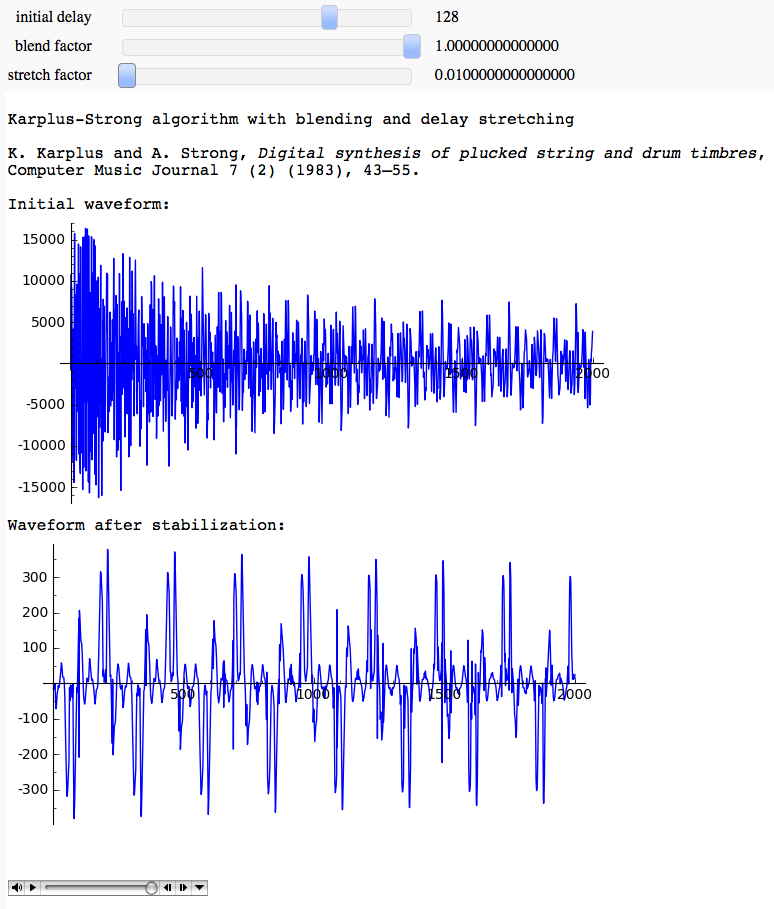
An Interactive Venn Diagram
xxxxxxxxxxdef f(s, braces=True): t = ', '.join(sorted(list(s))) if braces: return '{' + t + '}' return tdef g(s): return set(str(s).replace(',',' ').split())def _(X='1,2,3,a', Y='2,a,3,4,apple', Z='a,b,10,apple'): S = [g(X), g(Y), g(Z)] X,Y,Z = S XY = X & Y XZ = X & Z YZ = Y & Z XYZ = XY & Z pretty_print(html("<center><p>$X \\cap Y$ = {}</p><p> $X \\cap Z$ = {}</p><p> $Y \\cap Z$ = {}</p><p> $X \\cap Y \\cap Z$ = {}<center>".format(f(XY),f(XZ),f(YZ),f(XYZ)))) centers = [(cos(n*2*pi/3), sin(n*2*pi/3)) for n in [0,1,2]] scale = 1.7 clr = ['yellow', 'blue', 'green'] G = Graphics() for i in range(len(S)): G += circle(centers[i], scale, rgbcolor=clr[i], fill=True, alpha=0.3) for i in range(len(S)): G += circle(centers[i], scale, rgbcolor='black') # Plot what is in one but neither other for i in range(len(S)): Z = set(S[i]) for j in range(1,len(S)): Z = Z.difference(S[(i+j)%3]) G += text(f(Z,braces=False), (1.5*centers[i][0],1.7*centers[i][1]), rgbcolor='black') # Plot pairs of intersections for i in range(len(S)): Z = (set(S[i]) & S[(i+1)%3]) - set(XYZ) C = (1.3*cos(i*2*pi/3 + pi/3), 1.3*sin(i*2*pi/3 + pi/3)) G += text(f(Z,braces=False), C, rgbcolor='black') # Plot intersection of all three G += text(f(XYZ,braces=False), (0,0), rgbcolor='black') # Show it G.show(aspect_ratio=1, axes=False)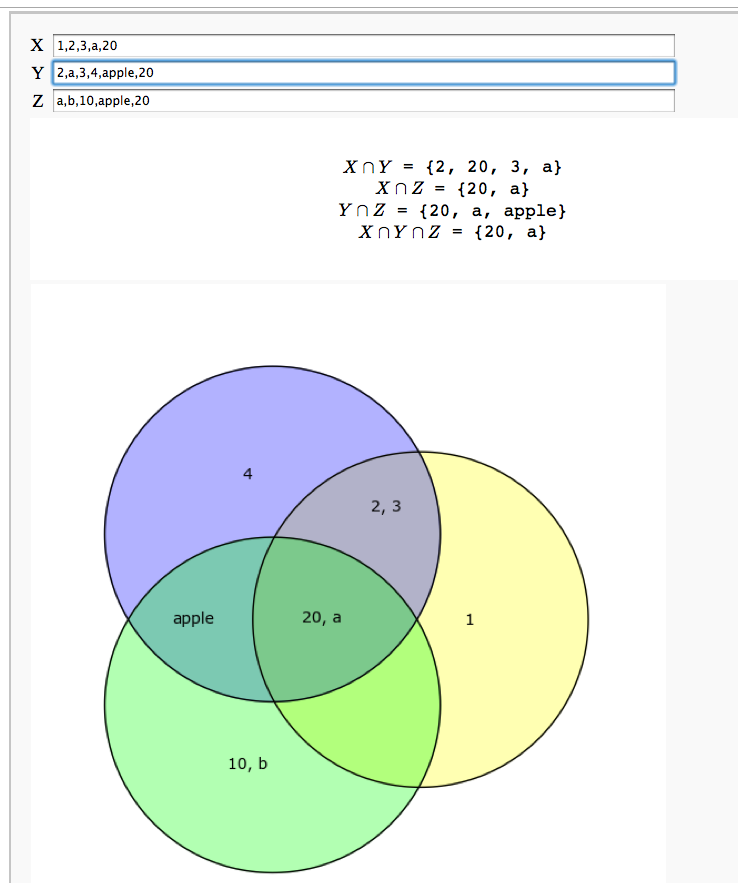
Unreadable code
by Igor Tolkov
xxxxxxxxxxdef _(h=(20,(1,36,1))): print((lambda f:f(0,f))( lambda n,f:'%s\n%s'%( ('*'*(2*n+1)).join([' '*(h-n-1)]*2), ((n<h-1 and f(n+1,f)) or '') ) ))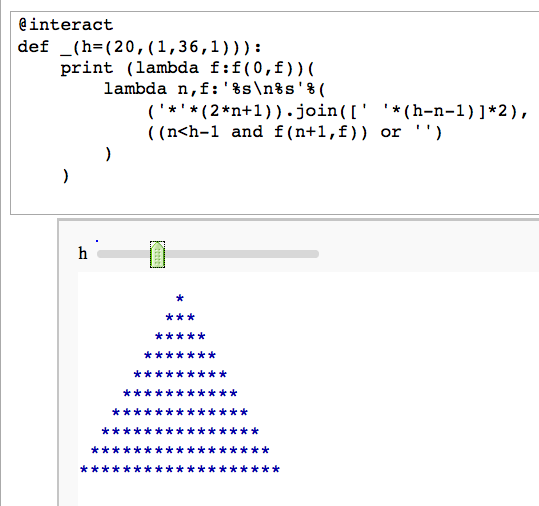
Profile a snippet of code
xxxxxxxxxxpretty_print(html('<h2>Profile the given input</h2>'))import cProfile; import profiledef _(cmd = ("Statement", '2 + 2'), do_preparse=("Preparse?", True), cprof =("cProfile?", False)): if do_preparse: cmd = preparse(cmd) if cprof: cProfile.runctx(cmd,globals(), locals()) else: profile.runctx(cmd,globals(), locals())
Evaluate a bit of code in a given system
by William Stein (there is no way yet to make the text box big):
xxxxxxxxxxdef _(system=selector([('sage0', 'Sage'), ('gp', 'PARI'), ('magma', 'Magma')]), code='2+2'): print(globals()[system].eval(code))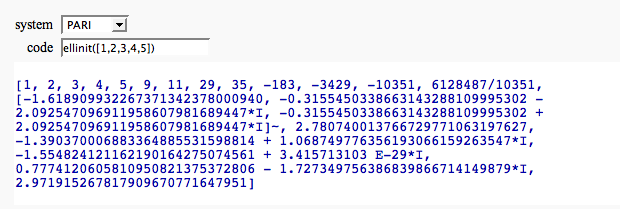
Minkowski Sum
by Marshall Hampton
xxxxxxxxxxdef minkdemo(list1, list2): ''' Return the Minkowski sum of two lists. ''' output = [] for stuff1 in list1: for stuff2 in list2: output.append([a + b for a, b in zip(stuff1, stuff2)]) return outputdef minksumvis(x1tri=slider(-1,1,1/10,0, label='Triangle point x coord.'), yb=slider(1,4,1/10,2, label='Blue point y coord.')): t_list = [[1,0], [x1tri,1], [0,0]] kite_list = [[3, 0], [1, 0], [0, 1], [1, yb]] triangle = polygon([[q[0]-6,q[1]] for q in t_list], alpha = .5, rgbcolor = (1,0,0)) t_vert = point([x1tri-6,1], rgbcolor = (1,0,0)) b_vert = point([kite_list[3][0]-4,yb], rgbcolor = (0,0,1)) kite = polygon([[q[0]-4,q[1]] for q in kite_list], alpha = .5,rgbcolor = (0,0,1)) p12 = minkdemo(t_list, kite_list) p12 = [[q[0],q[1]] for q in p12] p12poly = Polyhedron(p12) edge_lines = Graphics() verts = p12poly.vertices() for v0, v1 in p12poly.graph().edges(False): edge_lines += line([v0, v1]) triangle_sum = Graphics() for vert in kite_list: temp_list = [] for q in t_list: temp_list.append([q[i] + vert[i] for i in range(len(t_list[0]))]) triangle_sum += polygon(temp_list, alpha = .5, rgbcolor = (1,0,0)) kite_sum = Graphics() for vert in t_list: temp_list = [] for q in kite_list: temp_list.append([q[i] + vert[i] for i in range(len(t_list[0]))]) kite_sum += polygon(temp_list, alpha = .3,rgbcolor = (0,0,1)) labels = text('+', (-4.3,.5), rgbcolor = (0,0,0)) labels += text('=', (-.2,.5), rgbcolor = (0,0,0)) show(labels + t_vert + b_vert+ triangle + kite + triangle_sum + kite_sum + edge_lines, axes=False, figsize = [11.0*.7, 4*.7], xmin = -6, ymin = 0, ymax = 4)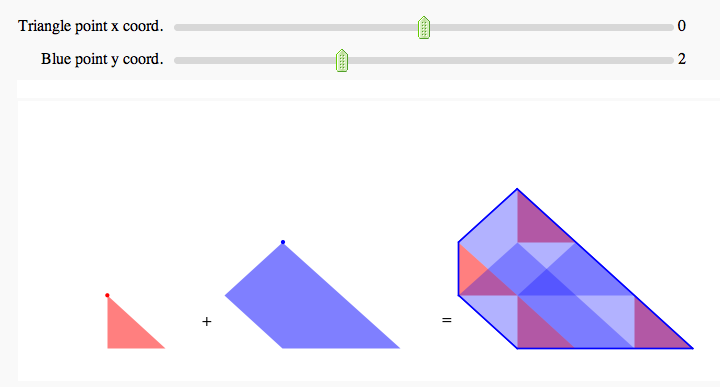
Cellular Automata
by Pablo Angulo, Eviatar Bach
xxxxxxxxxxfrom numpy import zerosfrom random import randintdef cellular(rule, N, initial='Single-cell'): '''Yields a matrix showing the evolution of a Wolfram's cellular automaton rule: determines how a cell's value is updated, depending on its neighbors N: number of iterations initial: starting condition; can be either single-cell or a random binary row ''' M=zeros( (N,2*N+2), dtype=int) if initial=='Single-cell': M[0,N]=1 else: M[0]=[randint(0,1) for a in range(2*N+2)] for j in range(1,N): for k in range(2*N): l = 4*M[j-1,k-1] + 2*M[j-1,k] + M[j-1,k+1] M[j,k]=rule[ l ] return M[:,:-1] def num2rule(number): if not 0 <= number <= 255: raise Exception('Invalid rule number') binary_digits = number.digits(base=2) return binary_digits + [0]*(8-len(binary_digits))def _( initial=selector(['Single-cell', 'Random'], label='Starting condition'), N=input_box(label='Number of iterations',default=100), rule_number=input_box(label='Rule number',default=110), size = slider(1, 11, label= 'Size', step_size=1, default=6 ), auto_update=False): rule = num2rule(rule_number) M = cellular(rule, N, initial) plot_M = matrix_plot(M, cmap='binary') plot_M.show( figsize=[size,size])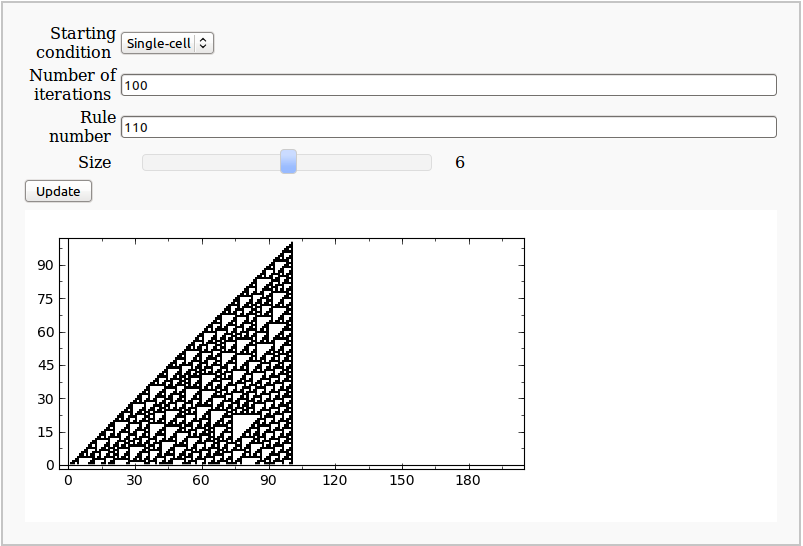
Another Interactive Venn Diagram
by Jane Long (adapted from http://wiki.sagemath.org/interact/misc)
This interact models a problem in which a certain number of people are surveyed to see if they participate in three different activities (running, biking, and swimming). Users can indicate the numbers of people in each category, from 0 to 100. Returns a graphic of a labeled Venn diagram with the number of people in each region. Returns an explanatory error message if user input is inconsistent.
xxxxxxxxxxdef _(T=slider([0..100],default=100,label='People surveyed'),X=slider([0..100],default=28,label='Run'), Y=slider([0..100],default=33,label='Bike'), Z=slider([0..100],default=59,label='Swim'),XY=slider([0..100],default=16,label='Run and Bike'),XZ=slider([0..100],default=13,label='Run and Swim'),YZ=slider([0..100],default=12,label='Bike and Swim'),XYZ=slider([0..100],default=7,label='Run, Bike, and Swim')): centers = [(cos(n*2*pi/3), sin(n*2*pi/3)) for n in [0,1,2]] scale = 1.7 clr = ['yellow', 'blue', 'green'] G = Graphics() for i in range(3): G += circle(centers[i], scale, rgbcolor=clr[i], fill=True, alpha=0.3) for i in range(3): G += circle(centers[i], scale, rgbcolor='black') # Label sets G += text('Run',(3,0),rgbcolor='black') G += text('Bike',(-1,3),rgbcolor='black') G += text('Swim',(-1,-3),rgbcolor='black') # Plot pairs of intersections ZX=XZ-XYZ G += text(ZX, (1.3*cos(2*2*pi/3 + pi/3), 1.3*sin(2*2*pi/3 + pi/3)), rgbcolor='black') YX=XY-XYZ G += text(YX, (1.3*cos(0*2*pi/3 + pi/3), 1.3*sin(0*2*pi/3 + pi/3)), rgbcolor='black') ZY=YZ-XYZ G += text(ZY, (1.3*cos(1*2*pi/3 + pi/3), 1.3*sin(1*2*pi/3 + pi/3)), rgbcolor='black') # Plot what is in one but neither other XX=X-ZX-YX-XYZ G += text(XX, (1.5*centers[0][0],1.7*centers[0][1]), rgbcolor='black') YY=Y-ZY-YX-XYZ G += text(YY, (1.5*centers[1][0],1.7*centers[1][1]), rgbcolor='black') ZZ=Z-ZY-ZX-XYZ G += text(ZZ, (1.5*centers[2][0],1.7*centers[2][1]), rgbcolor='black') # Plot intersection of all three G += text(XYZ, (0,0), rgbcolor='black') # Indicate number not in X, in Y, or in Z C = T-XX-YY-ZZ-ZX-ZY-YX-XYZ G += text(C,(3,-3),rgbcolor='black') # Check reasonableness before displaying result if XYZ>XY or XYZ>XZ or XYZ>YZ or XY>X or XY>Y or XZ>X or XZ>Z or YZ>Y or YZ>Z or C<0 or XYZ<0 or XZ<0 or YZ<0 or XY<0 or X<0 or Y<0 or Z<0: print('This situation is impossible! (Why?)') else: G.show(aspect_ratio=1, axes=False)